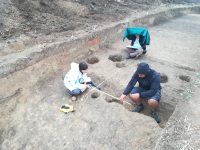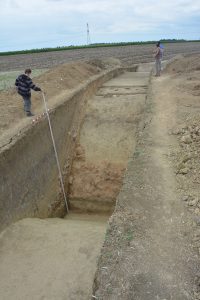Archaeologists have unearthed the remains of a massive Bronze Age citadel in the town of Sântana, Arad county, north-western Romania. An international team of German and Romanian archaeologists has been excavating the site, first explored in 2009, for two years and only a small fraction of it has been exposed. More than half of the site has been measured and mapped extensively via magnetic survey, however. Out of 90 hectares, 55 have been documented magnetometrically, allowing the team to map the fortress from outer defenses to the citadel’s main structures.
in the town of Sântana, Arad county, north-western Romania. An international team of German and Romanian archaeologists has been excavating the site, first explored in 2009, for two years and only a small fraction of it has been exposed. More than half of the site has been measured and mapped extensively via magnetic survey, however. Out of 90 hectares, 55 have been documented magnetometrically, allowing the team to map the fortress from outer defenses to the citadel’s main structures.
 The fortress was enclosed by a moat more than 13 feet deep outside of an earth rampart an estimated 70 feet high. These intimidatingly looming ramparts protected a palace in the interior. This massive structure was about 330 feet long and 130 feet wide. The palace and other structures inside the citadel were made of mud/clay and wood.
The fortress was enclosed by a moat more than 13 feet deep outside of an earth rampart an estimated 70 feet high. These intimidatingly looming ramparts protected a palace in the interior. This massive structure was about 330 feet long and 130 feet wide. The palace and other structures inside the citadel were made of mud/clay and wood.
Rüdiger Krause, professor at the Goethe University in Frankfurt, and Romanian professor Florin Gogâltan, from the Institute of Archeology and History of Art of the Romanian Academy in Cluj-Napoca, came to the conclusion that the “Old Citadel” in Sântana was built in the 14th century BC, about 3,400 years ago.
“The citadel in Sântana is one of the largest fortifications built during the mentioned period. Our purpose is to find out why this fortification was made, why this construction was needed,” the German professor said, according to Aradon.ro.
The discoveries also made the archeologists believe that the “Old Citadel” in Romania is much bigger than the ancient city of Troy.
“Troy had an area of 29 hectares, the Citadel in Sântana covers 89 hectares. The buildings of Troy were made of stone. At Sântana, the buildings were made of clay and wood, a sign that civilization was more developed and adapted to the building materials it had,” Florin Gogâltan explained. “We are facing one of the biggest and impressive fortresses in Europe.”
 And they want to give it its due. The director of the Arad Museum is advocating the construction of a new museum in Sântana on the site itself. The entirety of the site is not likely to be fully excavated — the current German-Romanian project is slated to last one more year only — but what has been revealed is in excellent condition. Local government officials are very much into the idea of creating a tourist attraction that would bring an infusion of cash to the area as well as international recognition of this unique and highly significant archaeological treasure.
And they want to give it its due. The director of the Arad Museum is advocating the construction of a new museum in Sântana on the site itself. The entirety of the site is not likely to be fully excavated — the current German-Romanian project is slated to last one more year only — but what has been revealed is in excellent condition. Local government officials are very much into the idea of creating a tourist attraction that would bring an infusion of cash to the area as well as international recognition of this unique and highly significant archaeological treasure.
One can mention Troy as many times as one likes, but we all know that without a good story it is just so much clay in the ground. The bottom line is that no one, given the choice of visiting ‘Troy’ or ‘something like Troy’, is going to choose the latter.
Welcome back following the database upgrade!
Ignorance is no longer a virtue… we cannot ignore that we are unearthing a greater aspect of history than the Troy legend we grew up listening to in grade school… it’s time to graduate into higher level learning as we are discovering more and more of Old Europe’s unwritten, or rather obscured, history.
“The buildings of Troy were made of stone. At Sântana, the buildings were made of clay and wood, a sign that civilization was more developed and adapted to the building materials it had,”
Does someone want to try to explain the connection made in that statement? It sounds like the speaker is saying wood and clay construction is more advanced than stone. Which doesn’t really make sense.
You build according to what’s available locally. For example the parts of Britain with good building stone used it – hence the loveliness of the Cotswold villages, for example. Hence Bath, Edinburgh, Aberdeen.
If there was no good stone you – monasteries, perhaps – might lavish money on imports. Else you used the timber and local clay – in the form of bricks. Those too can give beautiful buildings – see the Suffolk “wool” villages.
This sounds like a walled urban center so I’m not sure why the archaeologists refer to it as a citadel (a fort that controls/defends a city).
Stone buildings were rare in bronze age Troy. Even in the city’s citadel the houses were usually made of mudbrick on stone foundations. In the city proper stretching down to the bay the houses were made of wood and mudbrick. Anyway, that’s some white hot hype when he claims clay and wood construction shows they were more advanced than stone builders.
Yes, hail and praise to those faceless numines of server upgrades, they seem to have worked – Welcome back! The comparison is indeed an awkward one.
At the end of the day, “TROY” is just a label that the Romans and the Schliemann dude were using for the ‘Hisarlık’ hill, to be precise, only the part ‘a’ of the 7th civilization layer underneath of that hill. Notably, there was an ‘akropolis’ and indeed a corresponding ‘polis’.
Homer spoke of ‘Illion’ (Ἴλιον) and of ‘Τροίης ἱερὸν πτολίεθρον’, i.e. ‘the holy citadel of Troas’, presumably what the Hittites referred to as Wilusa, (Hittite: wi-lu-ša) or Wilusiya, being part of a confederation named Assuwa (alternatively, there is e.g. ‘Beycesultan’, which apparently was known in the Byzantine era as “Iluza”, and -frankly- why not a place in what today is Romania?).
Moreover, the “story” is already there, and Thracians are actually mentioned by Homer. Ῥῆσος is a ‘hellenised’ fictional Thracian king in Iliad, Book X, who fought on the side of Trojans, while the Odyssey kicks of with: Ἄνδρα μοι ἔννεπε, Μοῦσα, πολύτροπον, ὃς μάλα πολλὰ πλάγχθη, ἐπεὶ Τροίης ἱερὸν πτολίεθρον ἔπερσε·
——————————–
PS: In contrast to “Troy”, there is a massive Early Bronze Age battle site in Tollense Valley, and amber was traded through to Mycenae and Syria, and in between there were, yes indeed, Hittites. The common market with established rules, it seems, was not yet set up.
I wasn’t sure if it was hype, or a poor translation of what he actually said, but yes, an odd statement.